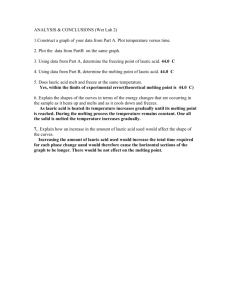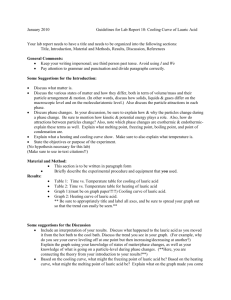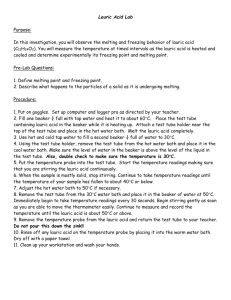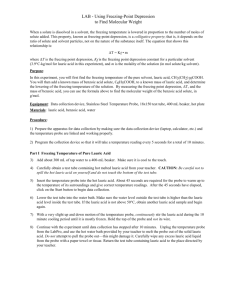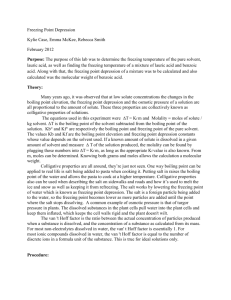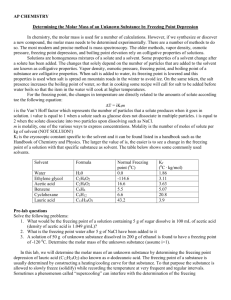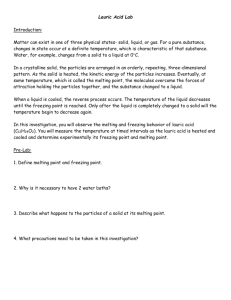Lab_Manual_files/15 Freezing Pt Depression
advertisement
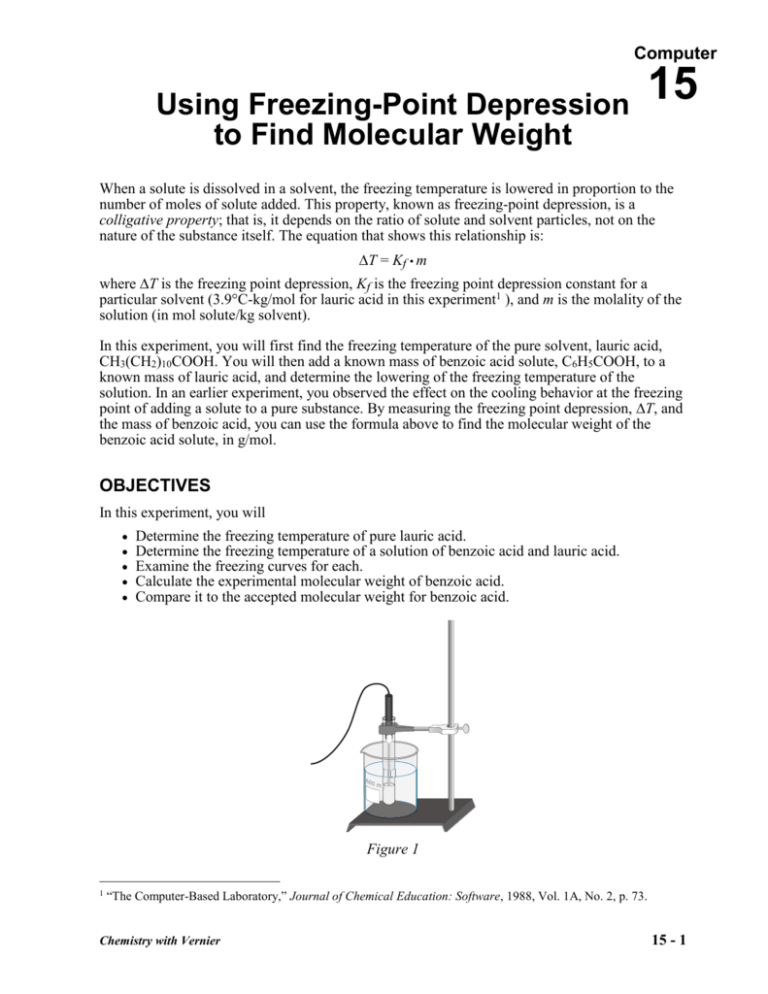
Computer Using Freezing-Point Depression to Find Molecular Weight 15 When a solute is dissolved in a solvent, the freezing temperature is lowered in proportion to the number of moles of solute added. This property, known as freezing-point depression, is a colligative property; that is, it depends on the ratio of solute and solvent particles, not on the nature of the substance itself. The equation that shows this relationship is: T = Kf • m where T is the freezing point depression, Kf is the freezing point depression constant for a particular solvent (3.9°C-kg/mol for lauric acid in this experiment1 ), and m is the molality of the solution (in mol solute/kg solvent). In this experiment, you will first find the freezing temperature of the pure solvent, lauric acid, CH3(CH2)10COOH. You will then add a known mass of benzoic acid solute, C6H5COOH, to a known mass of lauric acid, and determine the lowering of the freezing temperature of the solution. In an earlier experiment, you observed the effect on the cooling behavior at the freezing point of adding a solute to a pure substance. By measuring the freezing point depression, T, and the mass of benzoic acid, you can use the formula above to find the molecular weight of the benzoic acid solute, in g/mol. OBJECTIVES In this experiment, you will Determine the freezing temperature of pure lauric acid. Determine the freezing temperature of a solution of benzoic acid and lauric acid. Examine the freezing curves for each. Calculate the experimental molecular weight of benzoic acid. Compare it to the accepted molecular weight for benzoic acid. Figure 1 1 “The Computer-Based Laboratory,” Journal of Chemical Education: Software, 1988, Vol. 1A, No. 2, p. 73. Chemistry with Vernier 15 - 1 Computer 15 MATERIALS computer Vernier computer interface Logger Pro Temperature Probe 400 mL beaker ring stand utility clamp 18 150 mm test tube lauric acid benzoic acid thermometer PROCEDURE 1. Obtain and wear goggles. 2. Connect the Temperature Probe to the computer interface. Prepare the computer for data collection by opening the file “15 Freezing Pt Depression” from the Chemistry with Vernier folder. Part I Freezing Temperature of Pure Lauric Acid 3. Add about 300 mL of tap water with a temperature between 20 and 25°C to a 400 mL beaker. Place the beaker on the base of the ring stand. 4. Use a utility clamp to obtain a test tube containing hot melted lauric acid from your teacher. Fasten the utility clamp at the top of the test tube. CAUTION: Be careful not to spill the hot lauric acid on yourself and do not touch the bottom of the test tube. 5. Insert the Temperature Probe into the hot lauric acid. About 30 seconds are required for the probe to warm up to the temperature of its surroundings and give correct temperature readings. During this time, fasten the utility clamp to the ring stand so the test tube is above the water bath. Then click to begin data collection. 6. Lower the test tube into the water bath. Make sure the water level outside the test tube is higher than the lauric acid level inside the test tube. If the lauric acid is not above 50°C, obtain another lauric acid sample and begin again. 7. With a very slight up and down motion of the Temperature Probe, continuously stir the lauric acid during the cooling. Hold the top of the probe and not its wire. 8. Continue with the experiment until data collection has stopped after 10 minutes. Use the hot water bath provided by your teacher to melt the probe out of the solid lauric acid. Do not attempt to pull the probe out—this might damage it. Carefully wipe any excess lauric acid liquid from the probe with a paper towel or tissue. Return the test tube containing lauric acid to the place directed by your teacher. 9. To determine the freezing temperature of pure lauric acid, you need to determine the mean (or average) temperature in the portion of graph with nearly constant temperature. Move the mouse pointer to the beginning of the graph’s flat part. Press the mouse button and hold it down as you drag across the flat part of the curve, selecting only the points in the plateau. Click the Statistics button, . The mean temperature value for the selected data is listed in the statistics box on the graph. Record this value as the freezing temperature of lauric acid. Close the statistics box. Part II Freezing Temperature of a Solution of Benzoic Acid and Lauric Acid 10. Store your data by choosing Store Latest Run from the Experiment menu. Hide the curve from your first run by clicking on the vertical axis label and unchecking the appropriate box. Click . 15 - 2 Chemistry with Vernier Using Freezing-Point Depression to Find Molecular Weight 11. Obtain a test tube containing a melted solution with ~1 g of benzoic acid dissolved in ~8 g of lauric acid. Record the precise masses of benzoic acid and lauric acid as indicated on the label of the test tube. Repeat Steps 3-8 to determine the freezing point of this mixture. 12. When you have completed Step 8, click on the Examine button, point of the benzoic acid-lauric acid solution, you need to determine the temperature at which the mixture initially started to freeze. Unlike pure lauric acid, cooling a mixture of benzoic acid and lauric acid results in a gradual linear decrease in temperature during the time period when freezing takes place. As you move the mouse cursor across the graph, the temperature (y) and time (x) data points are displayed in the examine box on the graph. Locate the initial freezing temperature of the solution, as shown here. Record the freezing point in your data table. . To determine the freezing Freezing Point Time 13. To print a graph of temperature vs. time showing both data runs: a. Click on the vertical-axis label of the graph. To display both temperature runs, click More, and check the Run 1 and Latest Temperature boxes. Click . b. Label both curves by choosing Text Annotation from the Insert menu, and typing “Lauric acid” (or “Benzoic acid-lauric acid mixture”) in the edit box. Then drag each box to a position on or near its respective curve. c. Print the graph. PROCESSING THE DATA 1. Determine the difference in freezing temperatures, t, between the pure lauric acid (t1) and the mixture of lauric acid and benzoic acid (t2). Use the formula, t = t1 - t2. 2. Calculate molality (m), in mol/kg, using the formula, t = Kf • m (Kf = 3.9°C-kg/mol for lauric acid). 3. Calculate moles of benzoic acid solute, using the answer in Step 2 (in mol/kg) and the mass (in kg) of lauric acid solvent. 4. Calculate the experimental molecular weight of benzoic acid, in g/mol. Use the original mass of benzoic acid from your data table, and the moles of benzoic acid you found in the previous step. 5. Determine the accepted molecular weight for benzoic acid from its formula, C6H5COOH. 6. Calculate the percent error. EXTENSION Here is another method that can be used to determine the freezing temperature from your data in Part II. With a graph of the Part II data displayed, use this procedure: 1. Move the mouse pointer to the initial part of the cooling curve, where the temperature has an initial rapid decrease (before freezing occurred). Press the mouse button and hold it down as you drag across the linear region of this steep temperature decrease. 2. Click the Linear Fit button, Chemistry with Vernier . 15 - 3 Computer 15 3. Now press the mouse button and drag over the next linear region of the curve (the gently sloping section of the curve where freezing took place). Press the mouse button and hold it down as you drag only this linear region of the curve. 4. Click again. The graph should now have two regression lines displayed. 5. Choose Interpolate from the Analyze menu. Move the mouse pointer left to the point where the two regression lines intersect. When the small circles on each cursor line overlap each other at the intersection, the temperatures shown in either examine box should be equal to the freezing temperature for the benzoic acid-lauric acid mixture. DATA AND CALCULATIONS Mass of lauric acid g Mass of benzoic acid g Freezing temperature of pure lauric acid °C Freezing point of the benzoic acid–lauric acid mixture °C Freezing temperature depression, t °C Molality, m mol/kg Moles of benzoic acid mol Molecular weight of benzoic acid (experimental) g/mol Molecular weight of benzoic acid (accepted) g/mol Percent error % 15 - 4 Chemistry with Vernier
